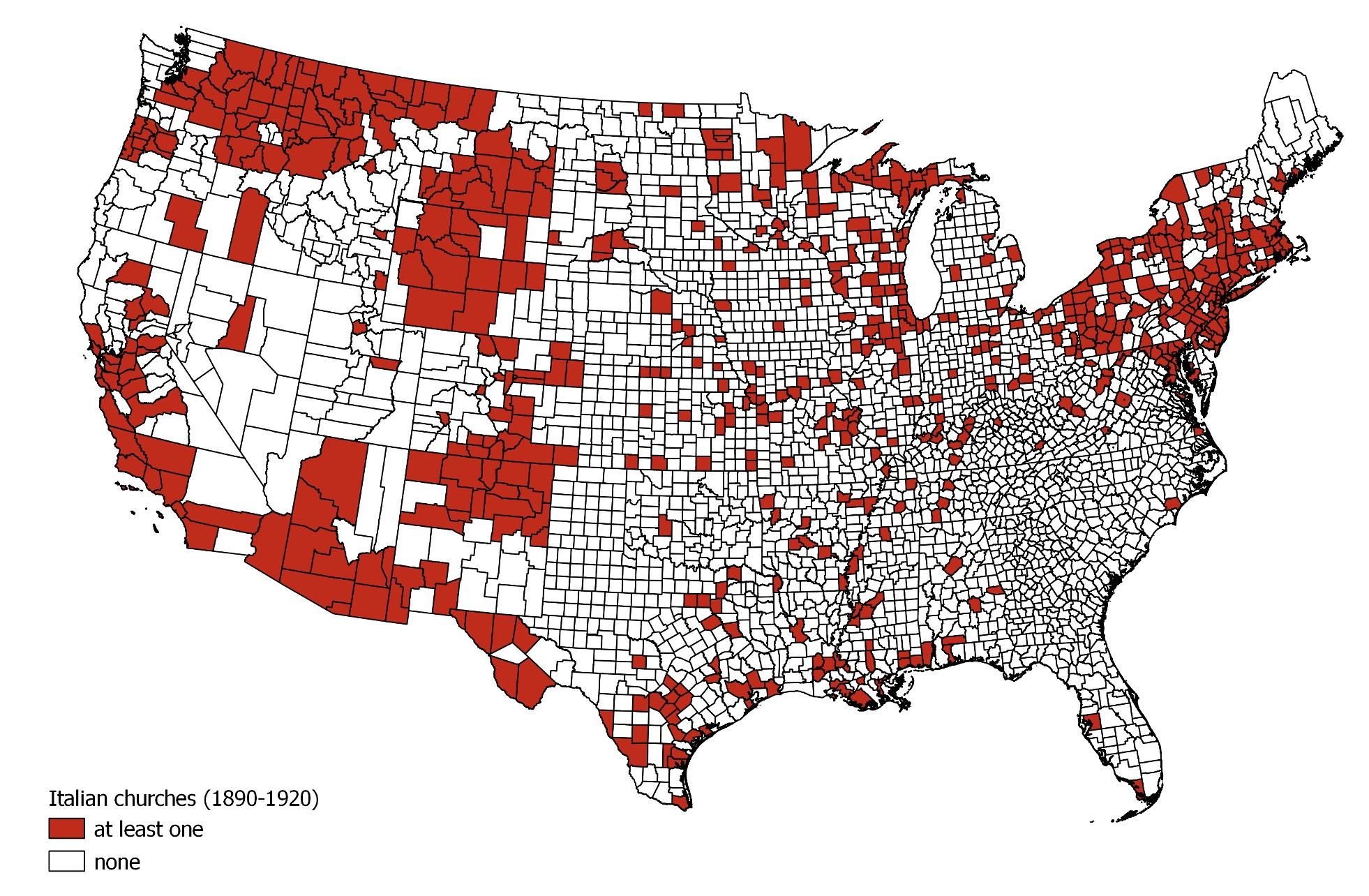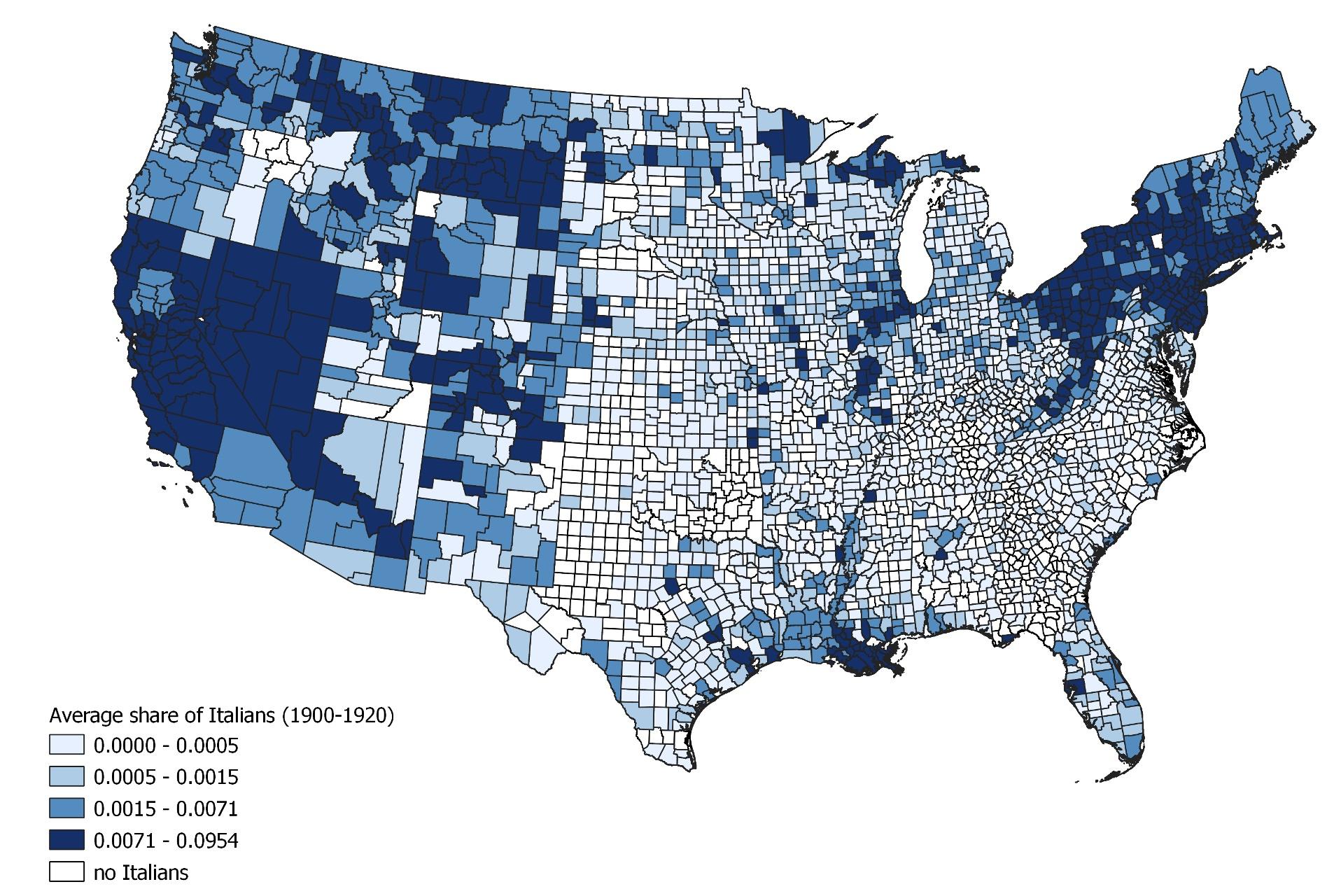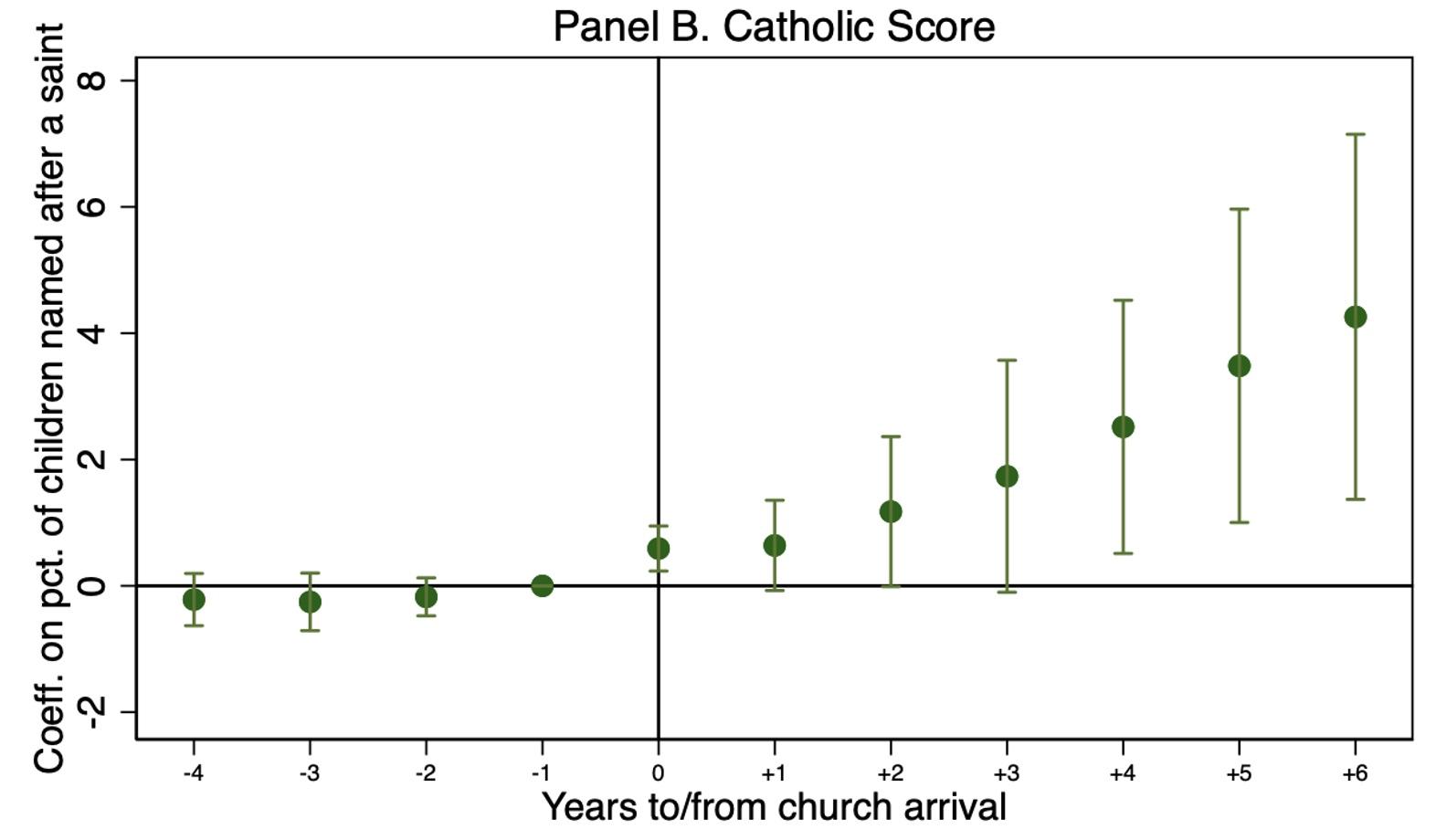Rising international migration flows have sparked a heated debate on the effects of immigrants on host societies. One recurring concern expressed by some native residents is that ethnic religious organisations might slow down immigrants’ willingness and ability to assimilate. Irrespective of their characteristics and the faith they are linked to, religious organisations are frequently blamed for perpetuating ethnic practices and for slowing the adoption of norms prevailing in the host society. In recent decades, Muslim immigrants have become the target of episodes of violence perpetrated by native residents (Abdelgadir and Fouka 2020, Bansak et al. 2016, Bisin et al. 2008, Müller and Schwarz 2020).
While the religious groups that trigger native residents’ hostility may differ across time and space, the current animosity is not a new phenomenon. In fact, between 1850 and 1920, when more than 30 million Europeans moved to the US during the Age of Mass Migration (Abramitzky and Boustan 2017), Catholic immigrants stirred up similar hostile reactions (Higham 1955, Spiro 2009).
Despite the salience of the topic, the effects of religious organisations on immigrants’ assimilation have remained surprisingly understudied. Moreover, they are ex-ante ambiguous. On the one hand, ethnic religious organisations may keep alive the legacy of national culture. On the other, they may alleviate the costs of immigration by providing spiritual and material support, thus helping immigrants stay in the destination country and making adaptation smoother. Religious organisations might also foster economic and social integration by providing key public goods such as education (Bazzi et al. 2020).
Our recent work (Gagliarducci and Tabellini 2022) tackles these questions and studies the effects of ethnic religious organisations on the social, cultural, and economic assimilation of immigrants. We consider the role of Italian Catholic churches in the US between 1890 and 1920, when more than 4 million Italians migrated to the US, representing the single largest national group at the time (Ferenczi 1929, Spitzer and Zimran 2018). One peculiar feature of the context we examine is that while Italian immigrants were homogeneously Catholic, the US was predominantly Protestant at the time because of the Anglo-Saxon settlers’ heritage (Gillis 2000). Furthermore, anecdotal and historical evidence highlights both the importance of the Catholic Church for Italian immigrants (Herberg 1983, Vecoli 1969) and the hostile reactions that the Church triggered among native residents at the time (Higham 1955).
We collect and digitise historical records on the arrival and the presence of Italian Catholic priests and churches that were identified by the Catholic hierarchy to serve the Italian community. Figure 1 maps the counties that had at least one Italian church between 1890 and 1920. We combine this novel dataset with the universe of Italian immigrants living in the US between 1900 and 1920, which we obtained from the full count US Census of Population. In Figure 2, we plot the average Italian immigrant share across US counties between 1900 and 1920, with darker colours reflecting a higher presence of Italian immigrants.
Figure 1 Presence of Italian Catholic churches (1890-1920)
Notes: Presence of at least one Italian Catholic church between 1890 and 1920.
Source: Authors’ calculations from Catholic Directories.
Figure 2 Average Italian immigrant share (1900-1920)
Notes: 1900-1920 average share of first-generation Italian immigrants (over county population).
Source: Authors’ calculations from IPUMS sample of US Census (Ruggles et al. 2020).
For each Italian immigrant, we count the number of years, within a decade, they were exposed to the presence of an Italian church in their county of residence. We then compare immigrants living in counties within the same state that were differentially exposed to an Italian Catholic church in the previous decade, holding constant county fixed and state time-varying unobservable characteristics.
To isolate the causal effect of church exposure, we further hold constant the trends in county penetration of Italian churches and allow Italians’ assimilation to evolve differentially across counties depending on several characteristics of the county in 1900, such as the size, affluence, and religiosity of the Italian community, which might be correlated with the timing of church arrival. Our empirical strategy is supported by abundant historical evidence that the timing of church arrivals within states and decades – the only source of variation exploited in our work – depended on idiosyncratic factors such as the entrepreneurial spirit of priests and missionaries, the destruction of a church due to a fire, the limited and unpredictable supply of priests from Italy, and long negotiations between the local Italian community and American bishops to buy a building or the land needed to establish the church.1
We find that Italian churches lowered the probability that Italians married and lived close to a US native of native parentage. According to our estimates, five additional years of exposure to an Italian Catholic church (slightly less than the sample average) reduce intermarriage rates and residential integration by 0.5 and 2 percentage points, respectively (or, 61% and 13% relative to the 1900 mean). Italian churches also lowered naturalisation rates.
Italian churches also increased parents’ tendency to name their (US-born) children after a Catholic saint, compared to siblings who were born before the arrival of the church. Figure 3 shows how Italian parents’ naming patterns evolved before and after the arrival of an Italian church (represented by the black vertical line corresponding to the zero on the x-axis).
Figure 3 Probability of naming a child after a Catholic saint
Notes: The figure plots the coefficient, with 95% confidence intervals, on leads and lags of a dummy equal to one for the entry of an Italian Catholic church in each county-(calendar) year. The dependent variable is the Catholic score, i.e., the percentage of US-born children (0-10) being named after a Catholic saint in the household. The vertical black line refers to the arrival of the church in the county.
For economic outcomes, the picture is more mixed. The presence of Italian churches increased Italians’ labour-force participation but reduced their occupational standing and the quality of their jobs, inducing Italian immigrants to specialise in more ‘typically Italian’ occupations (such as bootblacks, barbers, or fruit graders). These patterns are consistent with anecdotal accounts. They indicate that Italian priests made it easier for immigrants to find jobs via their ethnic networks but that such jobs limited the opportunities for occupational upgrading (Francesconi 1983).
We then investigate the mechanisms behind these patterns. First, and consistent with abundant historical evidence, churches increased coordination within the Italian community, acting as a catalyst for immigrants. For instance, following the entry of a church, intermarriage rates and residential integration declined more where the size of the Italian community was larger.
Second, using the local press to measure native residents’ attitudes, we document that the presence of Italian churches increased the probability that words such as ‘crime’ and ‘violent’ appeared together with the word ‘Italian’, reflecting disparaging ethnic stereotypes. This suggests that Italian churches raised backlash from long-time residents. We corroborate this interpretation by documenting that longer exposure to Italian churches was associated with a higher probability that a Ku Klux Klan klavern (local unit) opened in the county during the second era of the Klan (1915–1940), which was characterised by a strong anti-Catholic stance (Higham 1955).
Our findings suggest that Italian Catholic churches reduced the social and, to a lesser extent, economic assimilation of Italian immigrants. Yet, we also find evidence that they may have helped immigrants integrate along other dimensions. Specifically, immigrant children born in Italy and growing up in counties with longer exposure to an Italian church were more likely to speak English and be literate. This pattern was more pronounced for Italian churches that had an annexed school. In addition, Italian churches increased children’s ability to speak English – but not literacy – more in counties in states with compulsory English laws.
Our work focused on the short-run effects of religious organisations. Future research should study how ethnic religious organisations influence immigrants’ assimilation and, more broadly, social cohesion in the long run. Also, we did not examine how the arrival of Italian Catholic churches affected other ethnic groups. While other immigrant groups, especially non-Catholic ones, may have benefited from the change in native residents’ perceptions, the opposite scenario may have occurred as well. Finally, more evidence is needed from other contexts to compare patterns across time and space.
References
Abdelgadir, A, and V Fouka (2020), “Political secularism and Muslim integration in the West: Assessing the effects of the French headscarf ban”, American Political Science Review 114(3): 707–23.
Abramitzky, R, and L P Boustan (2017), “Immigration in American economic history”, Journal of Economic Literature 55(4): 1311–45.
Bansak, K, J Hainmueller and D Hangartner (2016), “How economic, humanitarian, and religious concerns shape European attitudes toward asylum seekers”, Science 354(6309): 217–22.
Bazzi, S, M Hilmy and B Marx (2020), “Islam and the state: Religious education in the age of mass schooling”, NBER Working Paper 27073.
Bisin, A, E Patacchini, T Verdier and Y Zenou (2008), “Are Muslim immigrants different in terms of cultural integration?”, Journal of the European Economic Association 6(2-3): 445–56.
Ferenczi, I (1929), “International migration statistics”, in International Migrations, Volume I: Statistics, NBER.
Francesconi, M (1983), History of the Scalabrinian Congregation, Volumes I-V, New York: Center for Migration Studies of New York.
Gagliarducci, S, and M Tabellini (2022), “Faith and assimilation: Italian immigrants in the US”, NBER Working Paper 30003.
Gillis, C (2000), Roman Catholicism in America, New York: Columbia University Press.
Herberg, W (1983), Protestant–Catholic–Jew: An essay in American religious sociology, Chicago: University of Chicago Press.
Higham, J (1955), Strangers in the land: Patterns of American nativism, 1860-1925, New Brunswick, NJ: Rutgers University Press.
Müller, K, and C Schwarz (2020), “From hashtag to hate crime: Twitter and anti-minority sentiment”, working paper.
Spiro, J P (2009), Defending the master race: Conservation, eugenics, and the legacy of Madison Grant, Burlington, VT: University of Vermont Press.
Spitzer, Y, and A Zimran (2018), “Migrant self-selection: Anthropometric evidence from the mass migration of Italians to the US, 1907–1925”, Journal of Development Economics 134: 226–47.
Vecoli, R J (1969), “Prelates and peasants: Italian immigrants and the Catholic Church”, Journal of Social History 2: 217–68.
Endnotes
1 In the paper, we also perform several placebo exercises documenting that Italian immigrants in counties that received an Italian church earlier were not assimilating at differential rates before the entry of the church.






